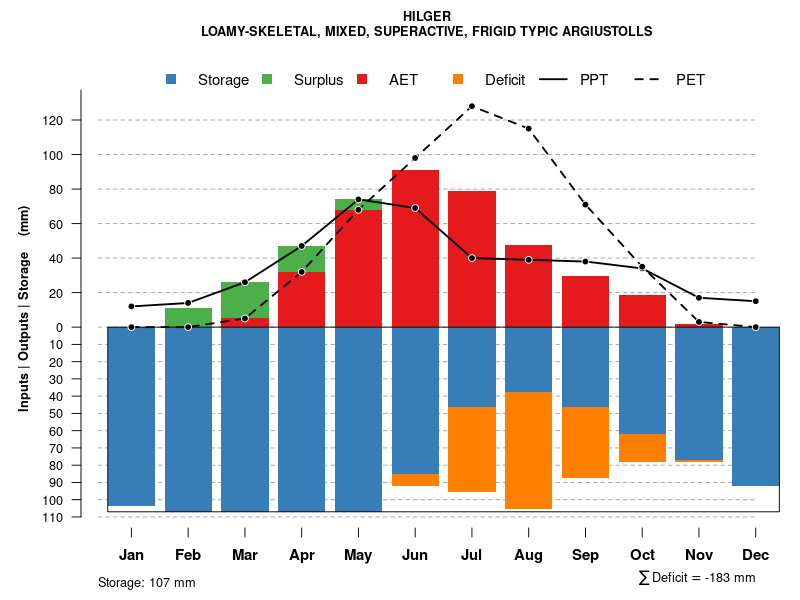| Hilger stony loam, 4 to 25 percent slopes | 252E | 582 | 344526 | ckhr | mt065 | 1996 | 1:24000 |
Hilger-Rock outcrop complex, 4 to 35 percent slopes | 252D | 385 | 344525 | ckhq | mt065 | 1996 | 1:24000 |
Hilger extremely stony loam, 8 to 25 percent slopes | HgE | 8611 | 147510 | 4yhd | mt609 | 1971 | 1:24000 |
Cheadle-Hilger complex, 10 to 60 percent slopes | 42 | 61426 | 341926 | cgsw | mt613 | 1975 | 1:24000 |
Hilger very stony loam, 15 to 50 percent slopes | 100 | 31158 | 341758 | cgmg | mt613 | 1975 | 1:24000 |
Hilger-Castner complex, 15 to 60 percent slopes | 101 | 25105 | 341759 | cgmh | mt613 | 1975 | 1:24000 |
Hilger very stony loam, 2 to 15 percent slopes | 99 | 12608 | 341988 | cgvw | mt613 | 1975 | 1:24000 |
Hilger, very stony-Hilger, rubbly-Rock outcrop complex, 8 to 35 percent slopes | 1564E | 1386 | 150631 | 51r2 | mt627 | 1998 | 1:24000 |
Martinsdale, stony-Martinsdale-Hilger complex, 2 to 8 percent slopes | 731C | 825 | 151308 | 52fx | mt627 | 1998 | 1:24000 |
Hilger, rubbly-Hilger complex, 8 to 25 percent slopes | 1563D | 529 | 150630 | 51r1 | mt627 | 1998 | 1:24000 |
Hilger-Farnuf stony loams, 8 to 35 percent slopes | 567D | 12143 | 147858 | 4yvm | mt630 | 1991 | 1:24000 |
Farnuf-Hilger stony loams, cool, 4 to 25 percent slopes | 499D | 5985 | 147831 | 4ytr | mt630 | 1991 | 1:24000 |
Mocmont-Tolex-Hilger very stony loams, 15 to 45 percent slopes | 384E | 3344 | 147801 | 4yss | mt630 | 1991 | 1:24000 |
Hilger-Regent-Castner stony loams, 15 to 35 percent slopes | 961E | 2885 | 147942 | 4yyb | mt630 | 1991 | 1:24000 |
Hilger stony loam, 2 to 8 percent slopes | 567B | 1690 | 147857 | 4yvl | mt630 | 1991 | 1:24000 |
Hilger extremely stony loam, 8 to 45 percent slopes | 100E | 571 | 147682 | 4yny | mt630 | 1991 | 1:24000 |
Hilger, very stony-Hilger, rubbly-Rock outcrop complex, 8 to 35 percent slopes | 1564E | 201 | 1703060 | 1v55f | mt635 | 2006 | 1:24000 |
Hilger-Wimper-Azaar complex, 4 to 15 percent slopes | 219D | 264 | 2438034 | 2mtz8 | mt638 | 1985 | 1:24000 |
Hilger-Castner-Rock outcrop complex, 25 to 60 percent slopes | 28 | 51670 | 348158 | cp8x | mt655 | 1975 | 1:24000 |
Winkler-Hilger-Rock outcrop association, steep | 64 | 20569 | 348198 | cpb6 | mt655 | 1975 | 1:24000 |
Hilger-Rock outcrop complex, 4 to 35 percent slopes | 252D | 812 | 1531651 | 1ndt3 | mt666 | 2008 | 1:24000 |
Hilger stony loam, 4 to 25 percent slopes | 252E | 757 | 1531653 | 1ndt5 | mt666 | 2008 | 1:24000 |
Hilger cobbly loam, moist, 6 to 40 percent slopes, cobbly | Q0528E | 725 | 2375754 | 2wcb7 | sd081 | 2007 | 1:24000 |
Hilger cobbly loam, moist, 0 to 6 percent slopes, cobbly | Q0528B | 199 | 2375753 | 2wcb6 | sd081 | 2007 | 1:24000 |
Hilger cobbly loam, moist, 6 to 40 percent slopes, cobbly | Q0528E | 194 | 2513969 | 2wcb7 | sd600 | 1974 | 1:24000 |
Hilger cobbly loam, moist, 0 to 6 percent slopes, cobbly | Q0528B | 65 | 2513967 | 2wcb6 | sd600 | 1974 | 1:24000 |
Hilger, cobbly-Bullflat complex, 6 to 40 percent slopes | Q0629E | 10053 | 2586592 | 2wcb5 | sd607 | 2011 | 1:24000 |
Bullflat-Hilger, cobbly complex, 0 to 6 percent slopes | Q0629B | 4959 | 2586524 | 2wcb4 | sd607 | 2011 | 1:24000 |
Hilger, cobbly-Metre, cool complex, 3 to 40 percent slopes | Q0630E | 3467 | 2586425 | 2wcb8 | sd607 | 2011 | 1:24000 |
Hilger cobbly loam, warm, 0 to 6 percent slopes | P166B | 615 | 2745660 | 2qt32 | sd607 | 2011 | 1:24000 |
Hilger, warm-Metre complex, 10 to 40 percent slopes | P168E | 564 | 2745663 | 2qt34 | sd607 | 2011 | 1:24000 |
Hilger cobbly loam, warm, 6 to 40 percent slopes | P166E | 478 | 2745661 | 2qt33 | sd607 | 2011 | 1:24000 |
Hilger, warm-Urban land complex, 0 to 6 percent slopes | P170B | 285 | 2745664 | 2qt35 | sd607 | 2011 | 1:24000 |
Hilger cobbly loam, moist, 0 to 6 percent slopes, cobbly | Q0528B | 106 | 2586571 | 2wcb6 | sd607 | 2011 | 1:24000 |
Hilger cobbly loam, moist, 6 to 40 percent slopes, cobbly | Q0528E | 77 | 2586501 | 2wcb7 | sd607 | 2011 | 1:24000 |
Hilger cobbly loam, warm, moist, 6 to 40 percent slopes | P167E | 36 | 2745662 | 2s03f | sd607 | 2011 | 1:24000 |
Meagher-Hilger complex, 0 to 6 percent slopes | 203 | 21459 | 1480220 | 1lp91 | wy041 | | 1:24000 |
Meagher-Beeno-Hilger complex, 3 to 30 percent slopes | 204 | 8131 | 1480219 | 1lp90 | wy041 | | 1:24000 |
Weed-Savar-Hilger, very stony complex, 2 to 25 percent slopes | 7C01 | | 3358321 | 30ztz | wy617 | | 1:24000 |
Pachel-like, stony-Hilger, stony-Zillion, very stony complex, 10 to 50 percent slopes | 2420 | | 3209066 | 2zdqz | wy629 | | 1:24000 |
Pachel-like, stony-Hilger, stony-Zillion, very stony complex, 10 to 50 percent slopes | 2420 | | 3253343 | 2zdqz | wy656 | 2008 | 1:24000 |













